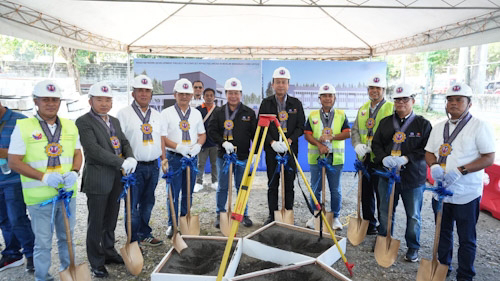COURTESY: Department of Public Works and Highways (DPWH)
The Department of Public Works and Highways (DPWH) has officially embarked on a game-changing journey with the launch of a two-storey Core Head Office Building. This project is more than just bricks and mortar; it's the operational hub that will kick off the implementation of the Parang East Diversion Road under the Road Network Development Project in Conflict-Affected Areas in Mindanao (RNDP-CAAM). This initiative is set to foster infrastructure development and economic growth in the Bangsamoro Autonomous Region in Muslim Mindanao (BARMM). Let's dive into how this development is shaping the future of Mindanao.
On November 29, 2024, a significant milestone was reached at the DPWH Maguindanao Project Management Office Compound in Cotabato City. DPWH Senior Undersecretary Emil K. Sadain and Project Director Benjamin A. Bautista led the groundbreaking ceremony, marking the official start of this transformative project. They were joined by key figures like OIC-Minister Danilo Ong of the Ministry of Public Works and Highways (BARMM), Mayor Cahar P. Ibay of Parang, and several other stakeholders. This collaborative effort underscores the importance of unity in driving regional development.
The project is a testament to the strong partnership between the Philippine and Japanese governments, with funding sourced through a loan from the Japan International Cooperation Agency (JICA). This collaboration aims to promote peace and development in Mindanao, illustrating how infrastructure can be a catalyst for sustainable change in conflict-affected areas. It's not just about roads; it's about building pathways to prosperity and stability.
One of the flagship components of RNDP-CAAM is the Sub-Project 8 (SP-8), aka the Parang East Diversion Road. This 7.074-kilometer project is designed to ease traffic congestion and improve accessibility as Parang transitions into BARMM’s administrative center. The road will connect various barangays, providing a much-needed alternative route to Polloc Port, BARMM’s only international port.
The project is more than just a road; it's a lifeline that will enhance connectivity, alleviate traffic, and boost regional economic activity. By improving the road and bridge networks, RNDP-CAAM aims to uplift communities, strengthen regional integration, and contribute to the long-term stability of conflict-affected areas. The construction involves four bridges, a two-lane concrete roadway, and extensive earthworks, drainage, and slope protection, showcasing the comprehensive nature of this endeavor.
Senior Undersecretary Sadain emphasized that this project reflects a robust partnership between the Philippine and Japanese governments. The collaboration with JICA exemplifies their commitment to supporting the Philippine government's efforts to promote peace and economic growth through infrastructure development. This partnership is not just about funding; it's about shared goals and mutual benefits.
The involvement of China Geo-Engineering (Phil) Corp and RD Interior Junior Construction as contractors highlights the international collaboration in infrastructure development. This blend of local and international expertise ensures the project's success and adherence to global standards. The joint efforts of these stakeholders are paving the way for a brighter, more connected future for Mindanao.
With the construction of the core head office building and the Parang East Diversion Road, the DPWH, through its Unified Project Management Office - Roads Management Cluster 1 (Bilateral), is laying the foundation for a brighter future in Mindanao. This project is not just about infrastructure; it's about hope, progress, and the promise of a better tomorrow.
The RNDP-CAAM covers the construction and improvement of 174.58 kilometers of access roads connecting BARMM, exemplifying JICA’s commitment to supporting the Philippine government. By improving road and bridge networks, the project aims to uplift communities, strengthen regional integration, and contribute to the long-term stability of conflict-affected areas.
In conclusion, the transformative potential of infrastructure in fostering sustainable development in conflict-affected areas is not just a dream; it's becoming a reality. The efforts of the DPWH and its partners are paving the way for peace, prosperity, and a connected future for the people of Mindanao. Here's to a future where roads lead not just to destinations, but to opportunities and better lives.



